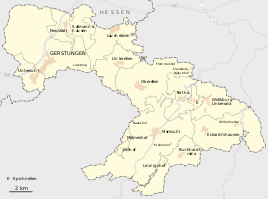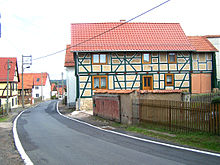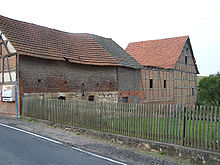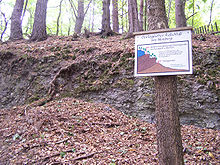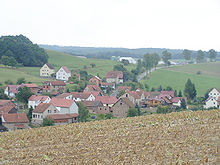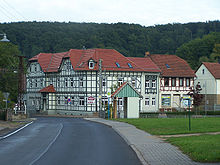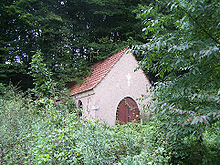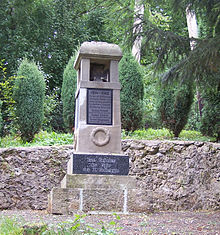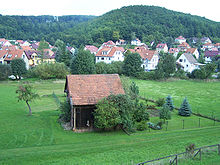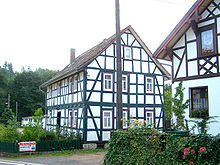Wolfsburg-Unkeroda
|
Wolfsburg-Unkeroda
community Gerstungen
|
|
|---|---|
| Coordinates: 50 ° 56 ′ 18 ″ N , 10 ° 16 ′ 3 ″ E | |
| Height : | 303 m |
| Area : | 9.07 km² |
| Residents : | 706 (December 31, 2016) |
| Population density : | 78 inhabitants / km² |
| Incorporation : | 6th July 2018 |
| Postal code : | 99834 |
| Area code : | 036925 |
|
Wolfsburg-Unkeroda in the east of the municipality
|
|
Wolfsburg-Unkeroda is a district of the Gerstungen municipality in the Wartburg district in the west of the Free State of Thuringia .
geography
Wolfsburg-Unkeroda is located in the western part of the Thuringian Forest , the Rennsteig runs for a length of six kilometers along the northern boundary of the district. The Unkeroda district is predominantly (about 70%) forested and part of a landscape protection area . The Wartburg and the city of Eisenach are not far from the village .
Neighboring places
The town of Eisenach borders the district of Wolfsburg-Unkeroda in the north from the historical border point Vachaer Stein, with the border predominantly running on the ridge line of the mountains. The Gerstung district of Eckardtshausen is adjacent to the east and south and the districts of Förtha and Epichnellen to the west . Large parts of today's Unkeroda corridor were part of the grand ducal hunting grounds of Wilhelmsthal Castle until 1919 .
mountains
The Wolfsburg-Unkerodas landscape is characterized by numerous mountains and incised narrow valleys, including north of the Elte: Ruppertskopf ( 413.6 m above sea level ), Saalkopf ( 429.6 m above sea level ), Wolfsrück ( 393 m above sea level) ), Elsterberg ( 407 m above sea level ), Hohe Sonne ( 445.7 m above sea level ), Oberer Karthäuserberg ( 413 m above sea level ) and the Klafterberg ( 357.7 m above sea level ). South of the Elte are: Knieberg ( 375.6 m above sea level ), Kirchberg ( 353.3 m above sea level ) and Weinberg ( 348.1 m above sea level ).
Waters
The Elte flows through the barely 200 m wide flood plain with a moderate gradient. On the approximately four-kilometer section in the district, it takes in the Bärenbach with the source streams Unkengraben, Raufengraben and Hellergraben, the Attchenbach and the Wallbach and other unnamed source streams. To operate the Attchenbach smelter, reservoirs and ponds were created along the stream of the same name.
history
First mentions
The first documentary mention of the settlement Unkeroda (in the spelling Onechenrode ) took place on the occasion of an acquisition of goods by the Monastery of Volkenroda in 1197. This tradition is recorded in a document that Landgrave Hermann von Thuringia had issued.
The Wolfsburg settlement was first mentioned in a document in 1247.
middle Ages
The location of a castle complex, from which the place name is derived, has not yet been proven. As early as 800, Wolfsburg was represented in a list of possessions of the Fulda monastery with a note on a piece of unearthed land not far from the Werra .
In the Middle Ages, both districts were located on side paths of the busy Via Regia , which can still be proven through countless preserved ravines in the woods. In the 14th century, Unkeroda only consisted of the upper courtyard and one lower courtyard . As a fiefdom , both districts belonged to the district of the Wartburg , but were owned by the Counts of Frankenstein , whose ancestral castle once stood near Bad Salzungen . From 1325 both districts came to the Allendorf monastery , which was the house monastery of the Frankenstein counts and was located in what is now Bad Salzung's district of Allendorf monastery . In 1358 the knight Hermann Losse , who lived in Eisenach, and his heirs from the Allendorf Monastery bought the (income) rights to the court in Unkeroda and in 1384 the Allendorf nuns finally transferred the last possessions to the Eisenach Marienstift. After a hunting accident in 1483, a stone cross had to be placed in atonement, which was named Wilde Sau - Kreuz .
16th Century
Around 1500 the Lords of Reckrodt had acquired extensive property and income in the Eltetal. They sat as lords of the castle on the nearby Brandenburg near Lauchröden. From 1520 they were in financial difficulties and had to cede their properties in Unkeroda, Neuenhof, Epichnellen, Wolfsburg and Sättelstädt step by step to the electoral administration. With the secularization of the church property in the 16th century, the remaining rights of the monasteries in both districts were then jointly owned by the dukes Johann Casimir and Johann Ernst . These decreed the formation of the rural community Wolfsburg-Unkeroda. At this time, copper mining in West Thuringia was expanded considerably. In order to be able to benefit from the silver and copper mining, the ores had to be smelted near the mines (initially in the Stedtfeldt area as well as Eckhardtshausen and Kupfersuhl). This required large quantities of charcoal, which in turn led to overexploitation of the forests. The inhabitants of the forest villages had found new sources of income by transporting wood and ore and as charcoal burners .
17th century
The inventories carried out after the Thirty Years' War in 1648 showed only 20 houses still habitable and 5 houses that were called desolate for the village of Wolfsburg-Unkeroda. There were still 15 men and 4 widows as adult residents in the village. With the discovery of new, abundant copper ore deposits , miners again moved into the Elte Valley and enabled another economic boom in the 17th century. To process the mined ores, a copper smelter was built in the Attchenbach corridor, and ponds and moats were created to operate the same. After the Seven Years' War several attempts were made to prevent the decline of the mining industry, but this did not succeed.
18th century
Construction of the Wilhelmsthal hunting lodge began in 1712 not far from the village of Wintershausen and was completed in 1719, for which the residents of the neighboring towns were requested to carry out construction and transport work. The first repairs were required there as early as 1740, followed by numerous expansions and modifications. The castle became the popular summer residence of the Weimar Duke Ernst August I , a passionate hunter. For this purpose, the villagers were committed to numerous hunts as drivers, hunting helpers and for supply and transport services. The Wilhelmsthaler See was dammed for the first time in 1745, which meant that there was at times a lack of water to operate the Unkerodaer mill. Even Goethe frequently visited Wilhelmsthal Castle and the nearby Attchenbacher copper smelter.
19th century
In 1827 124 people lived in Unkeroda and 98 in Wolfsburg. Most of them lived from agriculture and forestry, in Unkeroda a mill is mentioned. There has been a rail connection to Eisenach since 1858 , which significantly shortens the time-consuming and arduous crossing of the Rennsteig for the commuters who previously came to Eisenach on the Unkerodaer Marktweg and the Revolutionsweg . For the construction of the railway line, a 570 m long tunnel had to be blasted through the mountains. Mostly Italian construction workers were involved in the construction of the tunnel. The later mayor of Eisenach (1945–1946) and SPD politician Karl Hermann was born in Unkeroda in 1885 as the eldest son of a gardener.
20th century
Until World War II
At the beginning of the 20th century, the place began to open to tourism, especially on the spring weekends, crowds of visitors streamed from Eisenach and the Wartburg to Windbaghausen - as the place was now jokingly referred to in the press, and used the train for a comfortable return journey. Around the turn of the century, the desire to have its own church grew, but initially the place only received a small chapel at the forest cemetery, and the parish church in Eckhardtshausen was still used. 1922 Unkeroda was coupled to the electrical power grid connected.
The place first acquired the title of a state-recognized health resort in 1931. In order to further strengthen tourism , an outdoor swimming pool was opened in 1935 . In the same year the community got its own school.
The end of the war (1945)
At the end of the Second World War , the military situation in early April 1945 was marked by a pincer attack by US motorized units on the western Thuringian region. From April 1, the defensive lines along the Werra at Creuzburg and Vacha were overcome and the city of Eisenach and the Wolfsburg-Unkeroda area were included with the thrust towards Gotha and Breitungen. In this hopeless situation, the military, concentrated in the Wartburg city and in the forests of Mosbach, Unkeroda, Etterlösungen and around Eisenach and Ruhla , had to retreat under the orders of General Smilo Freiherr von Lüttwitz or were taken prisoner. Initially, most of the weapons and war material remained in the forests. On April 6, the American troops entered Eisenach and Unkeroda. On July 2, 1945, the Red Army took over the function of the occupying power in Thuringia in accordance with the contract . A memorial stone in the cemetery commemorates the fallen of the two world wars.
Wolfsburg-Unkeroda in the GDR era
During the GDR era, the number of inhabitants in Wolfsburg-Unkeroda rose rapidly to 900, compared to around 2500 guests a year from the FDGB holiday service . From 1954 to 1956 the village church was built on a hill above the Elte. It consists of two parts, a nave with a small apse and the parish hall arranged across the church. The working population found work in the Eisenach factories.
21st century
On July 6, 2018, Wolfsburg-Unkeroda was incorporated into the Gerstungen community.
Population development
Development of the population:
|
|
|
|
- Data source: from 1994 to 2016: Thuringian State Office for Statistics - values from December 31
Culture and sights
Village and club life is closely connected to the Wartburg city of Eisenach . For the Unkeroda population, the carnival, which has been celebrated since 1963, represents the cultural highlight of the year.
For years, an author's reading by the Eisenach bookstore Die Eule in the Unkerodaer Haus Waldfrieden has contributed to enriching cultural life . Prominent authors such as Hardy Krüger (several times), Martin Semmelrogge and, in December 2008, Ruth Maria Kubitschek appeared with their own works.
The place is connected to the nearby Rennsteig by numerous feeder paths. The Wilde Sau atonement cross, which is quoted in the local coat of arms, reminds of a hunting accident in 1483. The former beggar beech marks the north-western boundary of the district and at the same time an old court square on the historic Frankfurter Strasse at the Vachaer Stein hiking car park at the intersection of Rennsteig / Bundesstrasse 84 . Not far from the former Hohe Sonne hunting lodge is the Luisengrotte - a striking rock form in the Rotliegend . On the Elte, near the Attchenbacher ponds, you will find the former forester's lodge Attchenbach, which Goethe visited several times during his stays in the nearby Wilhelmsthal hunting lodge.
The 549 m long Förthaer tunnel on the railway line under the Rennsteig can be seen as a technical pioneering achievement . It was completed in 1858 when the Werra Railway was being built. The south portal is located about 1150 m north of the train station, there is a ventilation shaft directly on the Rennsteig.
The small village church above the Elte has a very filigree shape with the towering bell tower, it was built in 1913.
A home parlor in the premises of the municipal administration provides information about the development of the municipality and shows objects from everyday farm work.
politics
Former councilor
The council was composed of eight council members.
- CDU : 3 seats (−3)
- Free voters Wolfsburg-Unkeroda: 5 seats (+3)
(As of: local elections on May 25, 2014 )
Former mayor
Ralf Gasterstedt replaced the honorary mayor Elke Wagner on July 1, 2016.
Coat of arms
The wolf is the talking element for the place name. The cross with the boar's head symbolizes a historical stone cross on the Rennsteig on the border of the community hallway, which contains the representation of a hunting scene. The split mountain in the Schildfuß indicates the location in the Thuringian Forest. The split symbolizes the two districts. The coat of arms was confirmed as the local coat of arms on May 13, 1994.
traffic
Road traffic
Wolfsburg-Unkeroda is connected to the B 19 in the Eisenach - Meiningen section in an easterly direction via Landesstraße 3020 and to the B 84 in a westerly direction in Förtha , which in turn leads to Eisenach and the cities of Vacha , Bad Hersfeld and Fulda . In a southerly direction, Landesstraße 2115 leads via Eckardtshausen and Kupfersuhl to Möhra and Bad Salzungen .
The Bundesautobahn 4 can be reached via the federal highways 84 and 19 with the Eisenach-West and Eisenach-Ost junctions approximately ten kilometers to the north .
Rail transport
The Förtha train station of the Werra Railway is located directly on the municipal boundary of Förtha . Long-distance traffic is handled via the Eisenach train station .
Bus transport
The following bus lines run by the Verkehrsgesellschaft Wartburgkreis mbH run to Wolfsburg-Unkeroda:
| line | Driving distance |
|---|---|
| L-50 | Eisenach - Clausberg - Förtha - Wolfsburg-Unkeroda - Eckardtshausen |
| L-50a | Gerstungen - Oberellen - Förtha - Wolfsburg-Unkeroda - Eckardtshausen |
Reduced timetable - the bus is only available on school days and on workdays.
Personalities
- Karl Hermann (* 1885 in Unkeroda, † 1973 in Eisenach), politician of the SPD and later the SED
Individual evidence
- ^ Thuringian Land Survey Office Wartburgkreis and District Free City Eisenach , Erfurt 2002, ISBN 3-86140-250-5
- ↑ Official topographic maps of Thuringia 1: 10,000. Wartburgkreis, district of Gotha, district-free city of Eisenach . In: Thuringian Land Survey Office (Hrsg.): CD-ROM series Top10 . CD 2. Erfurt 1999.
- ↑ Thuringian Land Surveying Office TK25 - sheet 5027 Eisenach , Erfurt 1998, ISBN 3-86140-048-0
- ↑ Documents of the Margraves of Meißen and Landgraves of Thuringia, Dept. A: 948-1234, 3 vol., Ed. v. Otto Posse (Codex diplomaticus Saxoniae regiae IA). Leipzig 1881-98. CDS IA3 No. 26
- ^ Alfred Overmann (ed.): Document book of the Erfurt founders and monasteries . Halle 1926ff. Part 1. (706-1330) # 283
- ↑ Hartmut Uelle: Thuringian Wappenbuch . Ed .: Arbeitsgemeinschaft Genealogie eV Printing and Publishing House, Erfurt 1994, p. 213 . - Keyword Wolfsburg-Unkeroda
- ↑ Erwin Riske: Stone crosses and related landmarks in the Eisenach district , In: Eisenacher Schriften zur Heimatkunde, Heft 14, Eisenach 1981, pp. 42–46
- ↑ Erich Debes: The Wartburg Office in the first third of the 16th century . Eisenach 1926, p. 10.
- ^ Fritz Regel: The development of the localities in the Thuringian Forest - Perthes-Verlag, Gotha 1885, p. 66
- ↑ a b Municipal administration (ed.): Wolfsburg-Unkeroda in the Wartburgland - Eltetal . Eisenach 1994
- ↑ Eberhardt Matthes: From the history of the city and the district of Eisenach , In: Eisenacher Schriften zur Heimatkunde, Heft 4, Eisenach 1978, p. 80ff.
- ^ Siegmar Neuhaus One Hundred Years of Electric Power in West Thuringia Gotha 1997 ISBN 3-623-00745-5 , p. 27
- ↑ Willy Schilling: American booty policy in Thuringia In: Reinhard Jonscherer, Willy Schilling: Small Thuringian history. Jena 2005, ISBN 3-910141-74-9 , pp. 266-268
- ↑ Reinhold Brunner: The end of the war. Eisenach in April 1945. Wartburgland history, No. 5 Eisenach 2005.
- ↑ Thuringian Law and Ordinance Gazette No. 7 2018 of July 5, 2018 , accessed on July 6, 2018
- ↑ 2014 municipal council elections in Thuringia - preliminary result. The regional returning officer, accessed on June 17, 2014 .
- ↑ Website of the municipality, as of August 9, 2016. The regional returning officer, accessed on June 6, 2010 .
- ↑ Hartmut Uelle: Thuringian Wappenbuch . Ed .: Arbeitsgemeinschaft Genealogie eV Printing and Publishing House, Erfurt 1994, p. 213 .
- ↑ Road network map for Thuringia, accessed on November 10, 2010 at http://www.thueringen.de/imperia/md/content/tlsb/service/strassennetzkarte/th
- ↑ Timetable of the Verkehrsgesellschaft Wartburgkreis mbH

